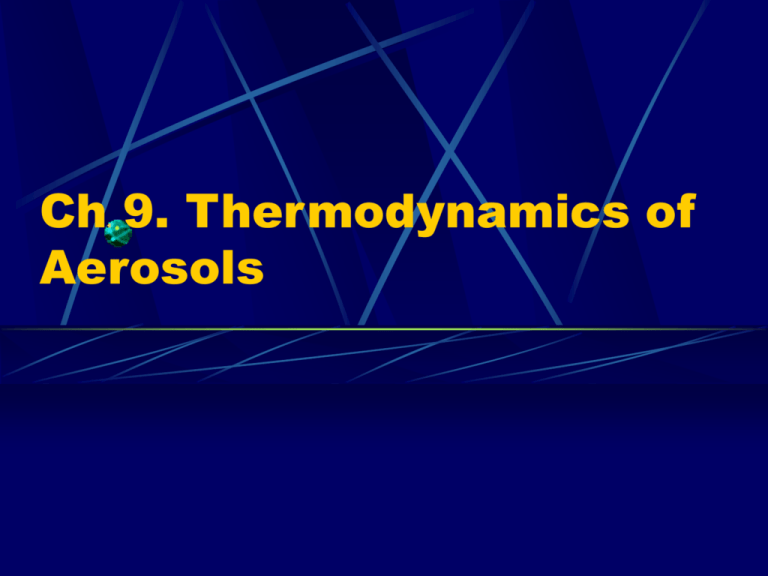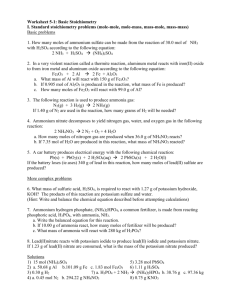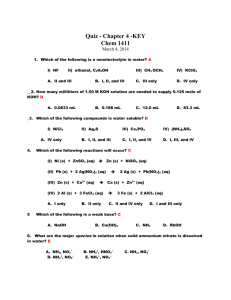Atmospheric Chemistry
advertisement

Ch 9. Thermodynamics of Aerosols CONTENTS 9.1 Thermodynamics Principles 9.2 Aerosol Liquid Water Content 9.3 Equilibrium Vapor Pressure Over a Curved Surface: The Kelvin Effect 9.4 Thermodynamics of Atmospheric Aerosol Systems CONTENTS • 9.1 Thermodynamics Principles • 9.1.1 Internal Energy and Chemical Potential • 9.1.2 The Gibbs Free Energy • 9.1.3 Conditions for Chemical Equilibrium • 9.1.4 Chemical Potentials of Ideal Gases and Ideal Gas Mixtures • 9.1.5 Chemical Potential of Solutions • 9.1.6 The Equilibrium Constant 9.1 Thermodynamics Principles Chemical Potential 藉由熱力學觀念討論Gas-Phase、 Aqueous Phase、Solid Phase三相平衡 SOLID=LIQUID Chemical Potential =f(T, P, ni) ni:the moles of species i •9.1.3 Conditions for Chemical Equilibrium 自發性反應趨向減少Gibbs free energy之方向進行 G 0 CONTENTS • 9.2 Aerosol Liquid Water Content • 9.2.1 Chemical Potential of Water in Atmospheric Particles • 9.2.2 Temperature Dependence of the DRH • 9.2.3 Deliquescence of Multicomponent Aerosols • 9.2.4 Crystallization of Single and Multicomponent Salts 9.2 Aerosol Liquid Water Content DRH(deliquescence relative humidity) Low RH aerosol solid Deliquescence:當RH開始增加至DRH 時,氣膠內特定組成會開始吸收水分, 藉以維持其其熱力學平衡關係,因而變 為水相。每一物種之DRH並不相同。 Crystallization:當RH下降時,其水分會 揮發形成結晶,但此RH與DRH並不相同。 例如 (NH4)2SO4 , fig 9.4 9.2 Aerosol Liquid Water Content 9.2 Aerosol Liquid Water Content DRH、Deliquescence、 Crystallization :與G相關 Deliquescence and Crystallization Deliquescence 當RH<DRH,,Solid之Gibbs free energy較低, 因而致使 (NH4)2SO4以Solid存在 當RH>DRH,Liquid之Gibbs free energy較低, 因而致使 (NH4)2SO4以Liquid存在 當RH=DRH,兩者之Gibbs free energy相同, 因而致使Solid會開始吸收水分 Gibbs free energy變化圖 Crystallization 當RH下降至DRH時,水分並不會在此時揮發。 RH持續下降,使氣膠成為超飽和溶液。帶其達 到臨界超飽和(Critical Supersaturation)後,即 發生再結晶現象 Gibbs free energy變化圖 9.2.1 Chemical Potential of Water in Atmospheric Particles Water Vapor (atmosphere): the order of grams per m3 of air. H2O concentration in the aerosol is less than 1 mg/m3 of air 氣膠相內水之濃度變化並不會影響大氣 中水蒸氣之濃度 氣膠熱力學模式計算時,可將ambient RH視為一常數 Water Activity H 2O( g ) H 2O( aq) H O( g ) H O 2 0 H 2O 9.2.1 Chemical Potential of Water in Atmospheric Particles 2 ( aq) RT ln pw * H 2O RT ln w (9.61) Pw: the water vapor pressure(in atm) w: the water activity in solution 純水平衡 w=1,pw=pw0(T, saturation vapor pressure) * 0 0 H O H O RT ln pw (9.62) 2 2 (9.61) 、(9.62)可得 pw RH w 0 pw 100 Water Activity 9.2.1 Chemical Potential of Water in Atmospheric Particles pw RH w 0 pw 100 由於Pw/Pw0即為相對濕度(0~1)之定義 大氣氣膠中之水活性(w)即為相對濕度(RH) 單一鹽類於DRH,H2O於氣相與氣膠相平衡 DRH ws 100 ws: the water activity of the saturated solution of the salt at T (It can be calculated from thermodynamic arguments ) 9.2.2 Temperature Dependence of the DRH 單一鹽類之DRH會隨溫度改變(推導)、(應用) H 2O( g ) H 2O( aq) H 2O( aq) nSs nS( aq) H s DRH T DRH 298 exp R 1 1 T A T 298 B ln 298 C T 298 n: the solubility of S in water(moles of solute/mole of water) (A、B、C) Hs: the enthalpy of solution of the salt(data) The solubility of S in water The enthalpy of solution of the salt DRH理論值與量測值比較 (NH4)2SO4之DRH變化較小, 即接近常數 NaNO3之DRH變化較大 DRH理論值與量測值比較(續) 混合鹽類(Mixed-Salt)之DRH會 下降 Temperature Dependence of the DRH H 2O( g ) H 2O( aq) (a) H 2O( aq) nSs nS( aq) b (a)式:水之冷凝熱(-Hv)即為水之蒸發熱 (Hv)之負值 (b)式:鹽類之溶解熱(Hs) The overall enthalpy change H nH s H v 溶液中水蒸氣於此溫度之變化=>Clausius-Clapeyron equation d ln pw d ln pw H v H s H n (9.67) 2 2 2 dT RT dT RT RT 純水 d ln pw0 H v dT RT 2 (9.68) 0 pw:溫度T 時之飽和蒸汽壓 Temperature Dependence of the DRH(續) 結合(9.67) 、(9.68) d ln pw / pw0 H s n dT RT 2 代入DRH關係式 H s d ln DRH / 100 n dT RT 2 代入n=A+BT+CT2,積分範圍T0~T DRH T H s ln DRH T0 R T0=298 K 1 1 T A B ln C T T 0 T0 T T0 H s DRH T DRH 298 exp R 1 1 T A T 298 B ln 298 C T 298 9.2.3 Deliquescence of Multicomponent Aerosols 多成分氣膠(Multicomponent Aerosols)之 吸水行為與單一鹽類相同。KCl-NaCl之 deliquescence growth、evaporation、 crystallization如fig 9.7。 Hydroscopic growth and evaporation of a mixed-salt particle Initial 66% mass KCl 34% mass NaCl Mixed-salt KCl NaCl DRH 72.7% 84.2% 75.3% 混合鹽類之DRH較 低 9.2.3 Deliquescence of Multicomponent Aerosols 推導雙電解質造成之DRH改變 Gibbs-Duhem equation:用於計算單一電解質 加入單一溶質水溶液中之DRH改變 於溫度T、壓力p,包含雙電解質(1,2)、水(w) n1d1 n 2d 2 n w d w 0 n1、n2、nw:the numbers of moles of electrolytes of 1, 2, and water 1、2、w:chemical potential 9.2.3 Deliquescence of Multicomponent Aerosols 推導雙電解質造成之DRH改變 初時假設electrolyte 1與固相鹽類1平衡,此時 並不包含electrolyte 2。 加入electrolyte 2, electrolyte 1之化學潛能尚未 改變,即d1=0。 electrolyte 2和H2O之化學潛 能 n 2dln 2 n w dln w 0 n 2 M w m2 nw 1000 m2: the molality of electrolyte 2 Mw: the molecular weight of water 1000 m 2 dln 2 dln w 0 nw 9.2.3 Deliquescence of Multicomponent Aerosols 推導雙電解質造成之DRH改變 積分m’2=0~m2 w m 2 M w m m '2 d 2 m '2 ' ln dm 2 ' ' 0 w 0 1000 2 m 2 dm 2 Wexler and Seinfeld(1991) d 2 0 dm 2 2 w m2 w m2 0 由上式可知加入electrolyte 2後,water activity會 減少,因而降低DRH 得知 (實例,NH4NO3 and NH4Cl) 1.DRH時之水活性最小(m2=0,左右兩項相等) 2.混合鹽類之DRH恆小於單一鹽類之DRH 9.2.3 Deliquescence of Multicomponent Aerosols NH4NO3 and NH4Cl 303 K DRH NH4Cl(only) 77.4% NH4NO3(only) 61.8% 1 3 2 5 4 7 6 兩電解質混合後, 潮解點相對濕度會 降低,最低達51%。 9.2.3 Deliquescence of Multicomponent Aerosols NH4NO3 and NH4Cl Solid Aqueous 1 - NO3-,NH4+,Cl- 2 NH4Cl NO3-,NH4+,Cl- 3 - NO3-,NH4+,Cl- 4 NH4Cl NO3-,NH4+,Cl- 5 - NO3-,NH4+,Cl- 6 NH4NO3 NO3-,NH4+,Cl- 1 3 2 5 6 4 7 7 NH4ClNH4NO3,RH<DRH*(51%) 不同RH時,氣膠內組成變化 9.2.3 Deliquescence of Multicomponent Aerosols 氣膠內組成變化(RH) 氣膠內組成:40%NH4NO3、60%NH4Cl RH:40%~90%(increase) No evaporation and condensation RH 51%* 60% 70% 71% xNH4NO3 0.811 0.73 0.42 - xNH4Cl 0.189 0.27 0.58 - Eutonic point:最低DRH 之相對組成點 如表9.4 DRH* (Mutual deliquescence points) 9.2.3 Deliquescence of Multicomponent Aerosols 多於三物種之相轉換圖(如圖9.9) • Solid:(NH4)2SO4、NH4HSO4、((NH4)3H(SO4)2)、NH4NO3 (Solid lines區分各主導solid,為phase boundary,線上為共 存。Label : DRH) • Aqueous:H+、NH4+、HSO4-、SO42-、NO3(Dashed lines說明反應發生方向) • Total Hydrogen= total moles of protons and bisulfate ions • Total Sulfate=total moles of sulfate and bisulfate ions • Dotted line乃指反應發生方向(path lines) ,乃指低於DRH 之RH(solid)減少時之進行方向。如:1 mole (NH4)2SO4形 成必須消耗2 moles NH4+、1mole SO42-,因而X、Y會改變。 9.2.3 Deliquescence of Multicomponent Aerosols X(Ammomia) Y(Sulfate) 1 1 DRH 80% Solid (NH2)4SO4 9.2.4 Crystallization of Single and Multicomponent Salts 1.再結晶過程會有延遲現象。 2.多種鹽類組成之粒狀物會顯示多個再結晶 點,如圖9.7。KCl-NaCl之組成有兩階段蒸發 過程:KCl(65%)、NaCl(62%) 3.Spann and Richardson(1985):氣膠組成 介於NH4HSO4和(NH4)2SO4組成, crystallization RH:10%~40%,於大氣中氣 膠並不會呈現固體 CONTENTS • 9.3 Equilibrium Vapor Pressure Over a Curved Surface: The Kelvin Effect • Aerosol : curved interface(not flat) • The effect of curvature:在此之前所討 論之物種蒸汽壓皆於一平面上,此一節 將討論物種A於氣膠粒狀物表面上之蒸汽 壓,其受曲面之影響 • Gibbs free energy •藉由形成單一液滴之Gibbs free energy 變化,引入表面張力相(Derived) • G=Gdroplet-Gpure vapor (Result) G for the formation of a single drop G Gdrpolet G pure water G N1 gv ngl 4Rp2 NT gv G n( gl gv ) 4Rp2 n 4R 3p 3vl G 4R 3p 3vl ( g l g v ) 4R p2 dp pA p p g l g v kT ln A0 pA pA g l g v kT 0 4R 3p kT G ln S 4R p2 3vl vl Species A、radius Rp、n molecules NT: total number of vapor initially After the drop forms: vapor, N1=NT-n gl、gv:the G of a molecules (Liquid and Vapor) : surface tension Rp: the radius of curvature n:the number of molecules in the drop k (gl-gv) (9-13) dG SdT Vdp i dni i 1 at T, dni=0 dg=vdp or dg=(vl-vv)dp vv>>vl, dg=-vvdp vv=kT/p 9.3 Equilibrium Vapor Pressure Over a Curved Surface: The Kelvin Effect Gibbs free change for formation of a droplet The behavior of G as a function of Rp G 0 Rp S<1 Both terms are positive G increase with Rp S>1 Surface tension Small Rp: Surface tension term dominates Large Rp: Bulk free energy dominates Bulk free energy 9.3 Equilibrium Vapor Pressure Over a Curved Surface: The Kelvin Effect The Kelvin effect(Derived) 液滴曲面對平衡蒸汽壓之影響 於一外凸液面,要拉住一分子之其他液體分 子數目比於一平面之液體數目為少,因而可 知,與一液滴達到平衡之蒸汽分子所產生之 氣壓要比平面液體之蒸汽壓高。 2M p A p exp RT l Rp 0 A 4R 3p kT G ln S 4R p2 3vl vl The Kelvin effect Gmaximum G* at Rp=Rp* the equilibrium at this point is metastable G 0) 0 S:Saturation ratio(p /p A A Rp :surface tension 2vl R kT ln S * p 2vl p A p exp kTRp 0 A 2M p A p exp RT l Rp 0 A or M:the molecular weight of the substance l:the liquid-phase density 9.3 Equilibrium Vapor Pressure Over a Curved Surface: The Kelvin Effect The Kelvin Effect 2M p A p exp RT l Rp 0 A Table 9.5為水與有機物之表面張力。298 K時,五種有機物之分子量(M/)為水之 3~6倍,但其表面張力皆為水之1/3倍。 9.3 Equilibrium Vapor Pressure Over a Curved Surface: The Kelvin Effect The Kelvin Effect Fig 9.12為H2O、DOP(typical organic compound)於不同粒徑時,受Kelvin effect影 響之大小 成長區 H2O:於0.1 m時,增加 2.1%;於0.01 m時增加 23%,可知約50 nm時, Kelvin effect影響顯著。 較高分子量有機物,如 DOP:<200 nm時,則需加 以考量 蒸發區 2M p A p A0 exp RT l Rp CONTENTS • 9.4 Thermodynamics of Atmospheric Aerosol Systems • 9.4.1 The H2SO4-H2O system • 9.4.2 The Sulfuric Acid-AmmoniaWater System • 9.4.3 The Ammonia-Nitric Acid-Water System • 9.4.4 The Ammonia-Nitric AcidSulfuric Acid-Water System • 9.4.5 Other Inorganic Aerosol Species 9.4 Thermodynamics of Atmospheric Aerosol Systems 9.4.1 The H2SO4-H2O system H2SO4-hydroscopic, extremely low RH 9.4.1 The H2SO4-H2O system Dp/Dp0:particle growth factor Dpoln(pH2SO4/p0H2SO4):Kelvin effect parameter How to use fig 9.13(1 m H2SO4-H2O droplet) RH 50%(negligible Kelvin effect) 90%(negligible Kelvin effect) H2SO4 Conc. 42.5% 18% Density() 1.32 1.1 B. P. 115 C 100 C 76 dyn/cm 73 dyn/cm 11 N 4N 0.55 g/cm3 of solution 0.2 g/cm3 of solution 1.48 2.12 1/1.48=0.68 m 2.12/1.48=1.43 m Kelvin effect parameter 11.310-4 m 9.210-4 m ln(pH2SO4/p0H2SO4) 11.310-4/0.68=16.6210-4 9.210-4/1.43= 6.410-4 1.0017 1.0006 Surface tension() Normality Mass concentration(xH2SO4) Particle growth factor(Dp/Dp0) pure H2SO4 (p /p0 ) 9.4.1 The H2SO4-H2O system The saturation vapor pressure of pure sulfuric acid, p0H2SO4 p0H2SO4=1.31.010-8 atm(1310 ppb) at 296 K (T dependence) H2SO4蒸汽壓於表面之變化,為H2SO4-H2O 混合物內組成、溫 度之函數 RH>50%,[H2SO4]<40% by mass,xH2SO4<0.1(T=20 C), H2SO4 equilibrium vapor pressure<10-12 mmHg。 [H2SO4]gas<[SO42-]aerosol 9.4.1 The H2SO4-H2O system The effect on the composition of atmospheric H2SO4-H2O droplets. Particle size>1 m,negligible Kelvin effect For smaller particles the H2SO4 mole fraction in the droplet is highly dependent on particle size. The water concentration increases as the RH increase. 9.4.1 The H2SO4-H2O system The composition of atmospheric H2SO4-H2O droplets H 2 SO4( g ) H 2 SO4( aq) H 2 SO4( g ) H HSO4 The vapor pressure of H2SO4(g) is zero over atmospheric particles The whole systembisulfate dissociation reaction HSO4 H SO42 Keq(298 K)=1.0110-2(mol/kg) 1.0110 The molar ratio of HSO4- to SO42- 2 mHSO 4 mSO2 4 The ratio is proportional to [H+] [H+],pH,[HSO4-] mol / kg 99 H2 H2 , SO42 mH mSO2 4 HSO mHSO 4 , SO42 HSO 4 mH 4 9.4 Thermodynamics of Atmospheric Aerosol Systems 9.4.2 The Sulfuric Acid-Ammonia-Water System T, RH, NH3, H2SO4, determine the aerosol composition 30%, 298 K, 10 g/m3 H2SO4 [NH3]/[H2SO4] <0.5 H2SO4 dominate 0.5~1.25 NH4HSO4 dominate 1.25~1.5 (NH4)3H(SO4)2 dominate 2 (NH4)2SO4 dominate >2 NH3, it does not change the aerosol composition [NH3],[H2SO4],H2O , total mass 0.5 1 1.25 2 9.4 Thermodynamics of Atmospheric Aerosol Systems 9.4.2 The Sulfuric Acid-Ammonia-Water System 75%, 298 K, 10 g/m3 H2SO4 [NH3]/[H2SO4] <0.5 H2SO4 dominate 0.5~1. 5 HSO4- dominate High NH3 SO42- dominate DRHNH4HSO4 40% DRH(NH4)3H(SO4)2 69% DRH(NH4)2SO4 80% Molar ratio=2, form (NH4)2SO4, loss water Liquid phaseSolid Phase 9.4 Thermodynamics of Atmospheric Aerosol Systems 9.4.2 The Sulfuric Acid-Ammonia-Water System NH3/H2SO4 molar ratio<0.5 Exist primarily as H2SO4 solution 0.5< NH3/H2SO4 molar ratio<1.5 Consist mainly as HSO4NH3/H2SO4 molar ratio=2 Consist mainly as (NH4)2SO4 NH3/H2SO4 molar ratio>2 Ammonia also exist in the gas phase 9.4 Thermodynamics of Atmospheric Aerosol Systems 9.4.3 The Ammonia-Nitric Acid-Water System NH3(g)+HNO3(g)NH4NO3(s) Condition:high NH3、high HNO3、lowSO422 Cases for NH4NO3 Ambient RH<DRHSolid Ambient RH>DRHLiquid 9.4 Thermodynamics of Atmospheric Aerosol Systems NH3(g)+HNO3(g)NH4NO3(s) T(K) DRH Ambient RH<DRHSolid 298 61.8% ln DRH 288 67% 723.7 1.6954 T Equilibrium condition (chemical potential of ideal gases and solids) NH HNO NH 3 3 4 NO3 * 0 0 NH NO NH HNO 4 3 3 3 exp RT K p T p NH pHNO 3 3 Kp(ppb2): estimated by van’t Hoff equation, shown as fig9.19, it is sensitive to T change ln Kp 84.6 24220 T 6.1ln T 298 9.4 Thermodynamics of Atmospheric Aerosol Systems NH3(g)+HNO3(g)NH4NO3(s) Lower TLower KpLower equilibrium values of the NH3 and HNO3 gas-phase concentrations Lower T shift the equilibrium of the system toward the aerosol phase, increasing the aerosol mass of NH4NO3(fig 9.20) 9.4 Thermodynamics of Atmospheric Aerosol Systems NH3(g)+HNO3(g)NH4++NO3-(9.92) Ambient RH>DRHLiquid(8~26 M) Strongly non-idealneed activity coefficient Equilibrium condition NH HNO 3 0 0 NH HNO NO3 NH 4 3 3 exp RT K 9.92 2 NH 4 NO3 mNH mNO 4 pHNO3 p NH 3 3 3 NH NO NH NO mNH mNO 4 3 4 3 pHNO3 pNH 3 4 3 2 NH 4 NO3 NH NO 4 3 298 298 298 K9.92 4 1017 exp 64.7 1 11.511 ln T T T Estimate K(T)Need “m”Need aerosol water content Fig 9.21 depicts the results of such a computation.(The product of the mixing ratios of ammonia and nitric acid over solution as a function of RH) 9.4 Thermodynamics of Atmospheric Aerosol Systems Aerosol water content (ZSR relationship, Zdanovskii-Stokes-Robinson relationship) Water activity=RH One needs to relate the tendency of the aerosol components to absorb moisture(RH) C i W i mi, o aw W: the mass of aerosol water(kg of water/m3 of air) Ci:the aqueous-phase concentration of electrolyte i (moles/m3 of air) mi,o(aw):the molality(mol/kg) of a single-component aqueous solution of electrolyte i (water activity, aw=RH/100)查表計算 9.4 Thermodynamics of Atmospheric Aerosol Systems NH3(g)+HNO3(g)NH4++NO3-(9.92) K p HNO3 NH 3 Y=1no (NH4)2SO4, 隨RH增加,濃度乘 積快速減少,可知主要以aerosol phase 為主。Water會使NH4NO3溶解,並使其 在aerosol phase量增加。 9.4 Thermodynamics of Atmospheric Aerosol Systems NH3(g)+HNO3(g)NH4++NO3-(9.92) Input RH, T, [TN], [TA],可知gas phase-aerosol phase平衡組成 [TN]=[HNO3(g)]+[NO3-] [TA]=[NH3(g)]+[NH4+] Kp/(RT)2[TN][TA]: no NH4NO3 [TN][TA]Kp/(RT)2: NH4NO3 formation Equilibrium Kp/(RT)2=[NH3(g)]e[HNO3(g)]e [NH4NO3]e=0.5([TA]+[TN]-[([TA]+[TN])2-4([TA][TN]-Kp/(RT)2)]0.5 [NH3(g)]=[TA]-[NH3NO3]e [HNO3(g)]=[TN]-[NH3NO3]e Kp 2 NH 4 NO3 mNH mNO K 9.92 4 3 9.4 Thermodynamics of Atmospheric Aerosol Systems 9.4.4 The Ammonia-Nitric Acid- Sulfuric Acid-Water System Gas Phase: NH3,HNO3,H2SO4,H2O Solid Phase:NH4HSO4, (NH4)2SO4, NH4NO3, (NH4)SO4·2NH4NO3, (NH4)2SO4 ·3NH4NO3,(NH4)3H(SO4)2 Aqueous Phase:NH4+,H+,HSO4-,SO42-,NO3-,H2O Two observations 1.Sulfuric acid possesses an extremely low vapor pressure(僅在 aerosol) 2.(NH4)2SO4 solid or aqueous is the preferred form of sulfate Two regime Ammonia Fig 9.23 SO42- form NH4NO3 Poor [TA]<2[TS] HSO4- No Rich [TA]>2[TS] SO42- Yes 9.4 Thermodynamics of Atmospheric Aerosol Systems 9.4.4 The Ammonia-Nitric Acid- Sulfuric Acid-Water System Low [NH3] : SO42- and HSO4As NH3 increase: NH4NO3 become important Aerosol water content : nonlinear(與其電解質組成變化有關) nonlinear Low NH3 High NH3 9.4 Thermodynamics of Atmospheric Aerosol Systems 9.4.4 The Ammonia-Nitric Acid- Sulfuric Acid-Water System sulfatereplacement by nitrate(HNO3 and NH3 react) sulfateNO3- , and NH4+, water, total mass The reduction of the mass is nonlinear 減少20 g SO42-/m3(from 30 to 10 g/m3) Dry aerosol mass 減少12.9 g/m3 只會增加10 g NO3-/m3 僅會減少2.9 g NH4+/m3 9.4 Thermodynamics of Atmospheric Aerosol Systems 9.4.5 Other Inorganic Aerosol Species 加入其他物種(Cl-、Na+)之熱力學計算 NaCl(s)+HNO3(g)NaNO3(s)+HCl(g) 2NaCl(s)+H2SO4(s) Na2SO4(s)+2HCl(g) NaCl(s)+H2SO4(s) NaHSO4(s)+HCl(g) Aerosol water content Suppose a solution contains 6 moles H+/m3, 6 moles Na+/m3, 7 moles Cl-/m3, 5 moles NO3-/m3 The 4 ions can combine in many ways to form electrolytes: HNO3, HCl, NaNO3, NaCl. Mass-balance CH+,m=CHNO3,m+CHCl,m CNa+,m=CNaNO3,m+CNaCl,m CCl+,m=CHCl,m+CNaCl,m CNO3-,m=CHNO3,m+CNaNO3,m Result Case C C C C HCl,m Cw HNO3,m NaCl,m NaNO3,m 1 6 0 1 5 2 4 2 3 3 3 1 5 6 0 1000 C NaCl ,m C NaNO3 ,m CHNO3 ,m CHCl ,m mw mHCl ,m mNaNO3 ,m mHNO3 ,m mHCl ,m mk ,a Y0,k Y1,k aw Y2,k aw2 Y3,k aw3 Y0,k,Y1,k,Y2,k: polynomial coefficients(table) Aerosol water content RPM input: TOTSO4, TOTNH3, TOTNO3 1. 分配: Temp, gas phase and aerosol phase TOTSO4皆為aqueous phase 2. Composition 1. SO42->2NH4+: all NH4+(NH4)2SO4、H2SO4、HNO3 2. 2NH4+>SO42-: (NH4)2SO4、NH4NO3、HNO3 3. Aerosol water content 依個別計算所得之物種莫爾濃度(in air)配合大氣相對溼度, 計算其相對吸水量,相加後即得氣膠含水量。 W i Mi mio a w mi 0 (aw ) Y0,i Y1,i aw Y2,i aw2 Y3,i aw3 Y’s 為 polynomial coefficients(如表) 計算含水率之重要參數(298.15 K) mi 0 (aw ) Y0,i Y1,i aw Y2,i aw2 Y3,i aw3 Y (NH4)2SO4 37% R.H.; 29.0 m 1.1065495×102 HNO3 0% R.H.; 22.6 m 2.306844303×101 H+/HSO40% R.H.; 30.4 m 3.0391387536×101 NH4NO3 62% R.H.; 28 m 3.983916445×103 (NH4)2SO4 37% R.H.; 29.0 m 1.1065495×102 2H+/SO420% R.H.; 30.4 m 3.0391387536×101 -3.6759197×102 -3.563608869×101 -1.8995055929×102 1.153123266×104 -3.6759197×102 -1.8995058929×102 5.0462934×102 -6.210577919×101 9.7428231047×102 -2.13956707×105 5.0462934×102 9.7428231047×102 -3.1543839×102 5.510176187×102 -3.1680155761×103 7.926990533×105 -3.1543839×102 -3.1680155761×103 6.770824×101 -1.460055286×103 6.1400925314×103 -1.407853405×106 6.770824×101 6.1400925314×103 1.894467542×103 -6.9116348199×103 1.351250086×106 -6.9116348119×103 -1.220611402×103 4.1631475226×103 -6.770046794×106 4.1631475226×103 3.098597737×102 -1.0383424491×103 1.393507324×105 -1.0383424491×103 0 Y 1 Y 2 Y 3 Y 4 Y 5 Y 6 Y 7







